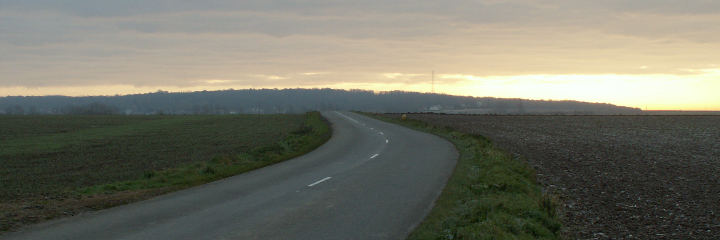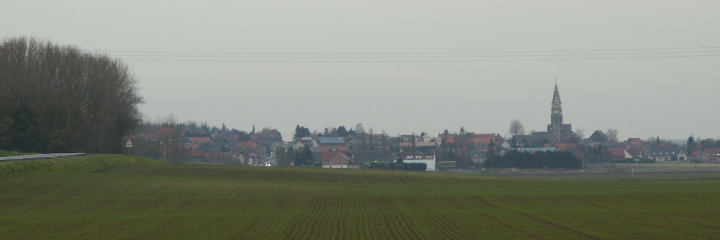Cambrai 1917
21 November 1917
IV Corps
On the 20th church bells had rung out a great victory back in the United Kingdom. Working in mutual support the tanks and infantry had advanced four or even five kilometres through some of the toughest defence works yet created. A large breach had been made in the Hindenburg Line for the cost of slightly more than 4 000 casualties. In comparison to previous attacks this was such an improvement that the number of prisoners captured outnumbered British casualties.
Only at Flesquières had there been any serious difficulties and, under the threat of being encircled, even that had been evacuated by the Germans during the night.
With the way now clear IV Corps was ordered to continue their assault in the direction of Bourlon Wood.
The imposing mass of this wood is an identifiable feature of the landscape visible from almost everywhere on the battlefield. Its height allows it to brood over the villages surrounding it and at night its silhouette forms a dark shadow on the horizon.
From their emplacements within the wood the Germans had a perfect view over the main road towards Cambrai and the villages of Anneux, Cantaing and Fontaine Notre Dame; the taking of which were vital to Byng's plans.

Bourlon Wood at dawn in November
The Tank Corps had suffered heavy losses and were rushing to recover, repair and refuel as many of their machines as possible. All of this had to be done in the rear areas.
The tanks of B Battalion, who were being refitted eight kilometres behind the lines, only received their orders at 0900 hours and were obviously not in a position to advance with the 51st (Highland) Division at the allotted time an hour later.
After waiting thirty minutes the infantry decided to go without them and immediately the 1/4th Gordon Highlanders ran into a storm of fire from a well defended Cantaing which sat just behind the Masnières - Beaurevoir trench system.
The 2nd Cavalry Brigade tried working their way round to the east of the village but were held up by the fact that the Germans were currently fighting to regain Noyelles on their right flank.
The tanks arrive
Just after midday 13 tanks of B Battalion arrived at the front and were quickly joined by the 2nd Dragoon Guards (Queen's Bays) in an assault on the south-east of Cantaing.
The guns of the tanks eliminated much of the resistance and supported by men from the 14th Durham Light Infantry (6th Division) they joined up with the Highlanders coming from the west of the village.
With the aid of the tanks it had taken only slightly more than an hour to subdue the village.
To the left of Cantaing the 1/7th Argyll and Sutherland Highlanders were assisted forward at 1500 hours by six tanks from H Battalion which dealt with the German field guns that had been impeding their advance.
Having taken Cantaing Mill the tanks and Argylls, now supported by the 1/4th Seaforth Highlanders, continued their advance into Fontaine Notre Dame.
Unbeknown to them, Major General Harper commanding the Division had issued orders that the attack was supposed to have halted at Cantaing until 62nd Division had dealt with Bourlon Wood, but this lack of information didn't stop the tanks from taking Fontaine and handing it over to the Highlanders shortly after nightfall.
General Harper's decision to halt rather than press his advantage signalled the closest the British were to get to Cambrai. Visiting the area today you can see that a roundabout and a few minutes drive is all that it takes to reach the town.

Fontaine Notre Dame from Anneux British Cemetery
The edge of Bourlon Wood is on the left
186th Brigade
Having successfully taken Graincourt the previous day the 186th Brigade of 62nd Division had continued their advance towards Anneux in front of them and Moeuvres on the canal bank. The orders for the tanks were again late in reaching F and G Battalions but they mustered as many as they could by Zero Hour.
As it was the tanks for Anneux arrived late but General Bradford was prepared to wait on them and the tanks and 2/4th Duke of Wellington's proceeded to crush all resistance within the village and reached their allotted positions in the trenches in front of Bourlon Wood.
The 2/7th in the centre went ahead without the tanks and made some progress but could then make no further impact on the German defences despite the aid of tanks which had moved up.
On the left and alongside the canal the 2/5th decided to bomb their way down the German trenches without waiting on the tanks but they had to wait on the armour to push on past a number of strong points.
Resistance everywhere was becoming appreciably stronger and by nightfall the men and tanks had done as much as they could. Some of the tanks had managed to penetrate into Bourlon Wood but the Germans were getting the hang of a new art in warfare: tank busting. Using anti-aircraft guns and armour piercing bullets they were becoming much more efficient at stopping the lumbering machines.
 Rumilly and Noyelles
Rumilly and Noyelles



